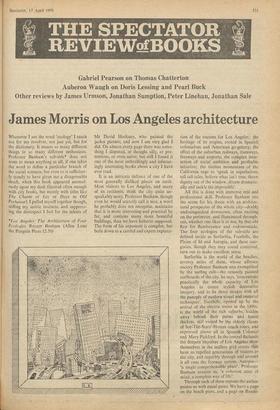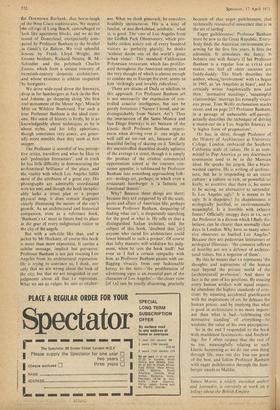THE SPECTATOR REVIEWaBOOKS
Gabriel Pearson on Thomas Chatterton Auberon Waugh on Doris Lessing and Pearl Buck Other reviews by James Urmson; Jonathan Sumption, Peter Linehan, Jonathan Sale
James Morris on Los Angeles architecture
Whenever I see the word 'ecology' I reach not for my revolver, not just yet, but for the dictionary. It means so many different things to so many different enthusiasts. Professor Banham's sub-title* does not seem to mean anything at all, if one takes the word to define a particular branch of the social sciences, but even so is sufficient- ly trendy to have given me a disagreeable shock, when this book appeared anomal- ously upon my desk (littered often enough with city books, but mostly with titles like The Charm of Isis or Days in Old Peshawar). I pulled myself together though, Stilling my satiric instincts, and suppress- ing the disrespect I feel for the talents of *Los Angeles: The Architecture of Four Ecologies Reyner Banham (Allen Lane the Penguin Press £2.50) Mr David Hockney, who painted the jacket picture; and now I am very glad I did. On almost every page there was some- thing I disputed, or thought silly, or pre- tentious, or even naïve; but still I found it one of the most enthrallingly and infuriat- ingly interesting books about a city I have ever read.
It is an intricate defence of one of the most generally disliked- places on earth. Most visitors to Los Angeles, and many of its residents, think the city quite un- speakably nasty. Professor Banham, though even he would scarcely call it nice, a word he probably does not recognise, maintains that it is more interesting and practical by far, and contains many more beautiful buildings, than we have hitherto supposed. The form of his argument is complex. but boils down to a careful and expert explana- don of the reasons for Los Angeles: the heritage of its origins, rooted in Spanish colonialism and American go-gettery; the effect of the suburban railways, tramways, freeways and airports; the complex inter- action of social ambition and profitable initiative; the tireless momentum of the California urge to 'speak in superlatives, tell tall tales, believe what isn't true, throw dignity out of the window, dream dramatic- ally and tackle the impossible'.
All this is done with immense zest and professional skill. Professor Banham sets the scene for his thesis with an architec- tural prospectus of the whole city—drably , undistinguished downtown, often exciting on the perimeter, and illuminated through- out, whether one likes it or not, by that old flair for flamboyance and rodomontade. The four ecologies of the sub-title are defined inside as Surfurbia, Foothills, the Plains of Id and Autopia, and these cate- gories, though they may sound contrived, turn out to make excellent sense.
Surfurbia is the world of the beaches, seventy miles of them, whose alfresco society Professor Banham sees exemplified by the surfing cult—the ornately painted surfboards of the city, he says, 'concentrate practically the whole capacity of Los Angeles to create stylish decorative imagery, and to fix those images with all the panoply of modern visual and material techniques'. Foothills, opened up by the arrival of the electric trains in the 1890s. is the world of the rich suburbs, hidden away behind their palms and laurel thickets. still visited by the elderly clients of See-The-Stars'-Homes coach tours, and expressed above all in Spanish Colonial and Mary Pickford. In the central flatlands the deepest impulses of Los Angeles show themselves in the endless grid streets that have so 'repelled generations of visitors to the city, and superbly through and around it all runs the freeway system. Autopia- `a single comprehensible place'. Professor Witham assures us, 'a coherent state of mind, a complete way of life'.
Through each of these regions the author guides us with equal gusto. We have a page on the beach piers, and a page on Bcauti- Ifni Downtown Burbank, that horse-laugh of the West Coast sophisticates. We inspect the oil rigs of Long Beach, camouflaged to look like apartment blocks, and we do the, round of Disneyland, unexpectedly com- pared by Professor Banham to the brothel in Genet's Le Balcon. We visit splendid houses by Frank Lloyd Wright, the Greene brothers, Richard Neutra, R. M.
Schindler and the polymath Charles lEames, which form a unique treasury of twentieth-century domestic architecture, land whose existence is seldom suspected lby foreigners.
We drive wide-eyed down the freeways, I drop in for hamburgers at Jack-in-the-Box I and Johnies, go shopping along 'the first , real monument of the Motor Age'. Miracle Mile on Wilshire Boulevard. For such a tour Professor Banham is the ideal cicer- one. His sense of history is lively, he is as knowledgeable about techniques as he is about styles, and his lofty aphorisms, though sometimes very comic, are gener- ally more sensible than they seem at first snigger.
The Professor is scornful of less percep- tive critics, travellers and what he likes to call 'pedestrian litterateurs', and in truth he has little difficulty in demonstrating the architectural brilliance of the place, and the vitality with which Los Angeles fulfils most of the attributes of a great city. His photographs are admirably coordinated with his text, and though the book inexplic- ably lacks a street plan or a proper physical map, it does contain diagrams clearly illustrating the nature of the city's growth. As an architectural and historical companion, even as a reference book, `Banham's LA' must in future find its place in the gear of every enlightened visitor to the city of the angels.
But with a sub-title like that, and a jacket by Mr Hackney, of course this book is more than mere exposition. It carries a subtler message, implicit but pervasive. Professor Banham is not just rescuing Los Angeles from its architectural reputation. He is trying to convince us, I think, not only that we are wrong about the look of the city, but that we are misguided in our. judgments about all that LA represents. What we see as vulgar, he sees as exuber- ant. What we think gimcrack, he considers healthily spontaneous. His is a kind of fatalist, or neo-Berkeleian, aesthetic: what is, is good. The view of Los Angeles from the Griffith Park Observatory, which pro- bably strikes ninety out of every hundred visitors as perfectly ghastly, he thinks 'without doubt one of the world's great urban vistas'. The standard Californian Polynesian restaurant, which has prolifer- ated throughout the American empire, and the very thought of which is almost enough to confine me to Europe for ever, seems to him 'strikingly and lovably ridiculous'.
There are strains of Dada or nihilism to this approach. For Professor Banham art is not necessarily the expression of con- trolled creative intelligence, but can be purely fortuitous (`Nature I loved, and in- distinguishably from Nature, Art'). Thus the intersection of the Santa Monica and San Diego freeways is art because of the kinetic thrill Professor Banham experi- ences when driving over it: one might as well call an ice-rink art, because of the beautiful feeling of skating on it. Similarly the uncontrolled shambled shoddy ugliness of the average LA street, though it is simply the product of the crudest commercial opportunism aimed at the coarsest con- sumer appetite, is sublimated by Professor Banham into something approaching folk- art—ecology-art, perhaps, in which even a restaurant hamburger is 'a fantasia on functional themes'.
Why? Because these things are there; because they are supported by all the scale, gusto and allure of American life; perhaps because Professor Banham, despairing of finding what isn't, is desperately searching for the good in what is. He tells us that a distinguished Italian architect, told the subject of this book, 'doubted that [sic] anyone who cared for architecture could lower himself to such a project'. Of course that lofty maestro will withdraw his judg- ment, when he sees the book itself: hut even so I feel a certain sympathy with him, as Professor Banham passes with un- flagging vivacity from one fashionable heresy to the next—`the proliferation of advertising signs is an essential part of the character of Los Angeles'—`the closer view [of LA] can be totally disarming, precisely because of that eager guilelessness,, that technically resourceful innocence that is in the art of surfing'.
Eager guilelessness! Professor Banham must be new to the Great Republic. Every. body finds the American environment dis- arming for the first few years. It fires the adrenalin. It stimulates the fancy. I bolsters one with flattery (1 bet Professor Banham is a regular lion at UCLA) and makes one feel all older societies are fuddy-duddy. The blurb describes the author, whosey'involvement' with LA began in 1965, as 'an Angelina at heart', and he certainlY writes Angelenically now and then: 'normative standings', 'meaningful relationships' interrupt his normally vivaci• ous prose, Torn Wolfe exclamation marks occur, and on page 217 Professor Banham, in a passage of unbeatable self-parody. actually describes the technique of driving a motor-car on a Los Angeles freeway as 'a higher form of pragmatism'.
He has, in short. though Professor of the History of Architecture at University College, London, embraced the Southern , California scale of values. He is as com- mitted, to Pop America as any doctrinaire communist used to be to the Marxian ideal. He speaks the jargon, like a brain- washed captive. He is writing of architec- ture, but he is responding to an entire culture: a culture so rich, so powerful. so lively, so assertive that there is, he seems to be saying, no alternative to surrender. is Los Angeles ugly? It is meant to be ugly. Is it shapeless? Its shapelessness is ecologically justified, or environmentally meaningful. is it horrible with exhaust fumes? Officially smoggy days in LA, says the Professor in a dictum which !flatly dis- believe, can be clearer than normally clear days in London. Why have so many sensi- tive observers so loathed Los Angeles? Because they are pedestrian litterateurs or ecological illiterates: 'the common reflexes of hostility are not a defence of architec- tural values, but a negation of them'.
By this he means that I.A represents 'the thoughts and aspirations of the human race beyond the private world of the [architectural] profession'. And there in fact is the sum of his positions. By treating every human artifact with equal respect. he abandons the highest standards of criti- cism; by equating accidental gratification with the inspirations of art, he debases the human genius; and by implying that what is good in architecture is no more import- ant than what is bad—`celebrating the normative standing' of everything—he weakens the value of his own perceptions.
So in the end I responded to the book with maddened fascination—and forebod- ing: for I often suspect that the rest of us too, meaningfully relating to each kinetic happening as we do our own thing through life, may one day lose our grasp of the best, and follow Professor Banham with eager guilelessness through the ham- burger stands to Malibu.
James Morris, a widely travelled author and journalist, is currently at work on a trilogy about. the British Empire







































 Previous page
Previous page